
7 Best Practices for Handling SMS Subscriber Responses
Few things are worse than a “read” notification without a response (just the thought makes us cringe). It's why the Internet is full of “no text back” memes. While this modern faux pas can be good for a laugh, it also brings up an important lesson in SMS etiquette: when your subscribers text you, you should always text them back.
Failing to respond to incoming text messages in a timely manner not only makes subscribers feel unimportant—it also ruins the magic of SMS. No other marketing channel allows brands to build one-to-one relationships with their customers at scale. To keep those relationships healthy, though, you’ve gotta nurture them—and that means meeting and exceeding the expectations your subscribers have when they communicate with you over text.
Of course, you can’t manage responding to hundreds (or even thousands) of inbound subscriber texts the same way you manage your personal inbox. With that in mind, here are our top tips for handling two-way interactions with subscribers in a way that enhances their experience with your brand—without draining all the time out of your day.
1. Plan out conversational sends in advance.
When we say “conversational,” we mean messages designed to drive responses. In some cases, you can set up automated replies for conversational campaigns and automations (for example, those that use keywords). This definitely takes some of the heavy lifting out of responding, and many of these flows can run in the background. (However, keep in mind that they may produce a handful of responses that fall outside of your automated triggers, meaning you would need to reply manually.)
Here’s an example of a conversational message that uses keywords to trigger automated responses:
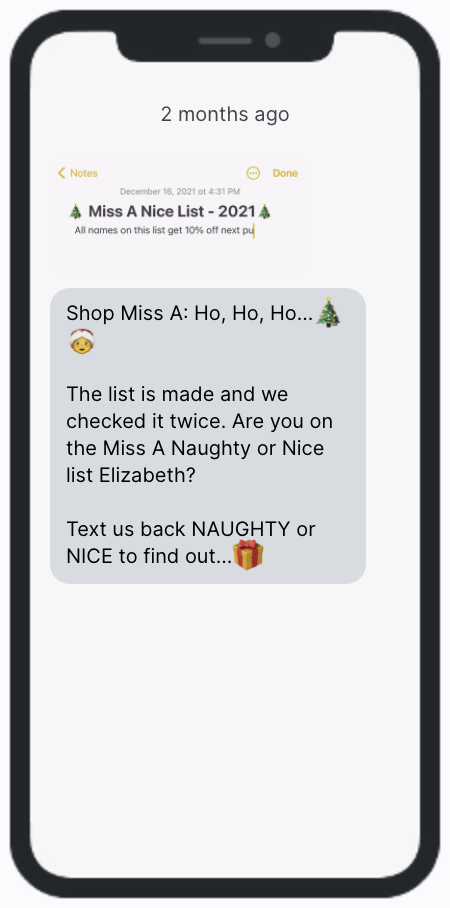
For this interactive holiday campaign, Miss A asked subscribers whether they were on the naughty list or the nice list. They could reply “NAUGHTY” or “NICE” to find out what was in store for them.
Subscribers then received one of the following two auto replies depending on which keyword they texted back:
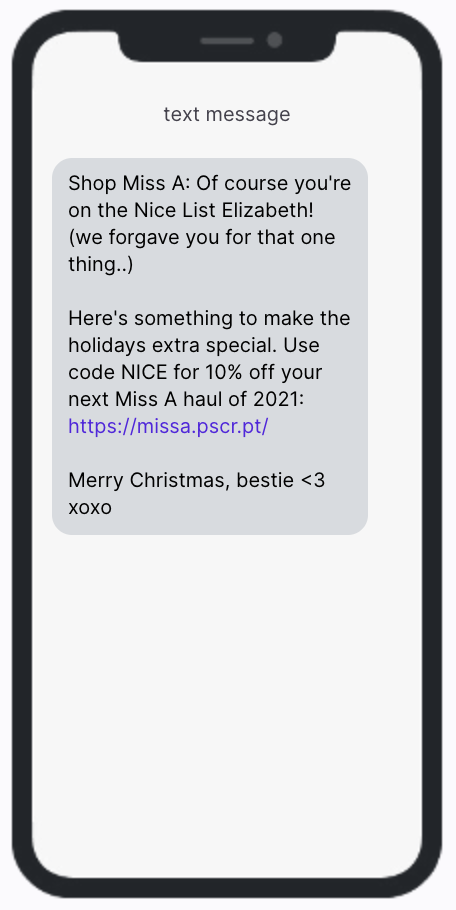
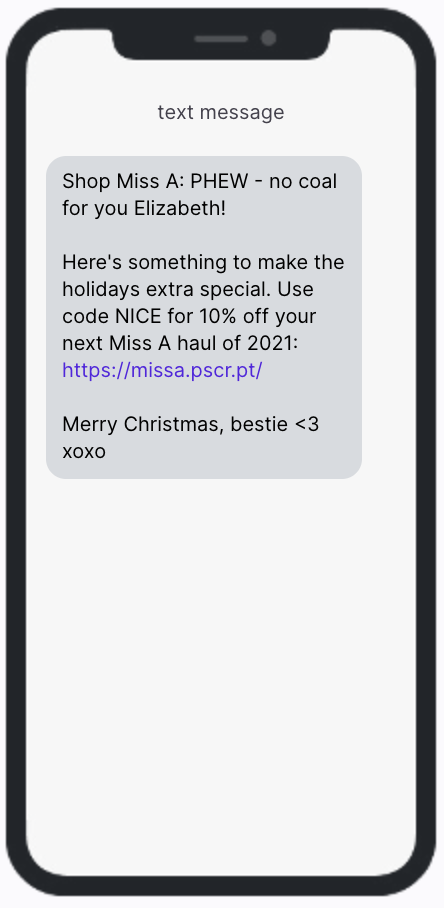
And here’s a fun example from OLIPOP. They sent this campaign asking subscribers to respond with their favorite flavor (out of the six provided choices):

They had six different auto replies ready to fire as soon as a subscriber texted back their flavor keyword. Here are a few examples:
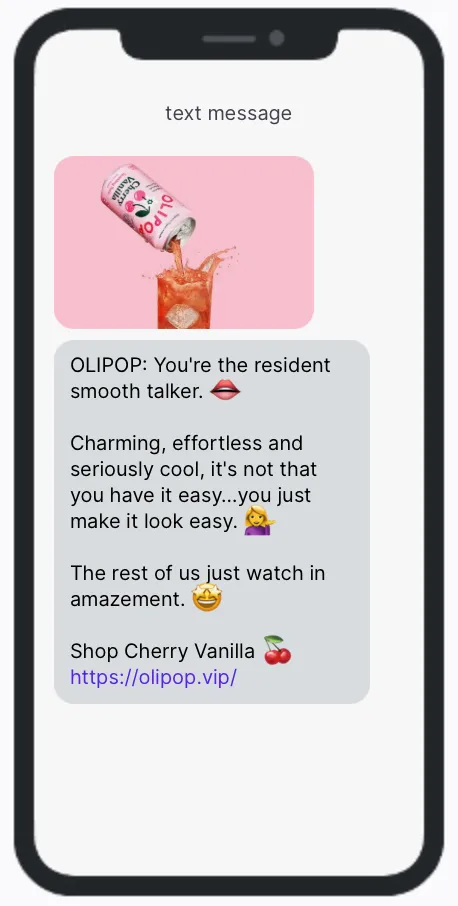
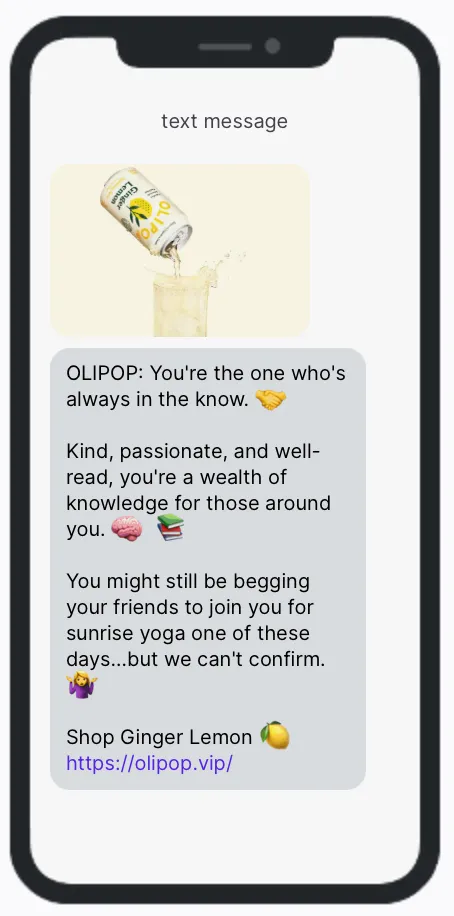
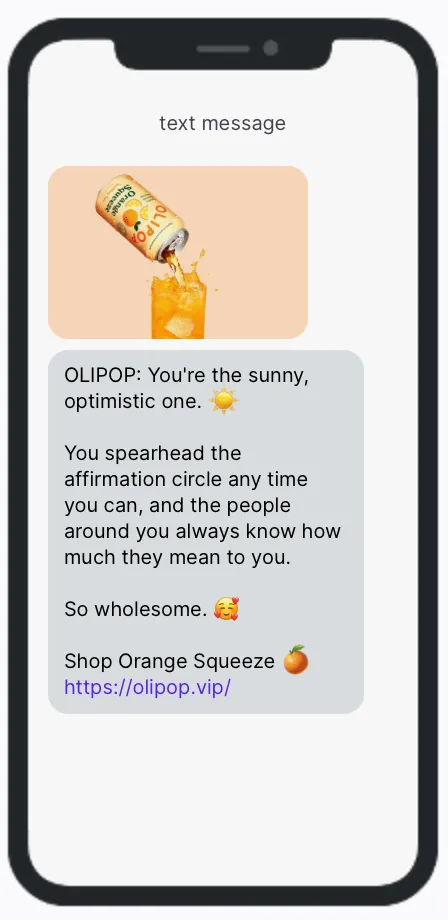
Responses automated via keywords are pretty straightforward. What you really need to be mindful of, though, is when—and how often—you plan to send conversational messages that require mostly unique (and therefore, manual) responses.
According to Ally Chapman, Retention Marketing Manager at handcrafted greeting card brand Lovepop, the hardest part of doing conversational campaigns well—beyond coming up with a great concept, of course—is rounding up folks to assist with fielding incoming messages. Asking people to contribute to this sort of effort on top of their own to-do lists can be a lot.
“The biggest challenge is definitely figuring out a unique angle for [an interactive campaign],” Chapman said. “And the second-biggest challenge is just lining up support for the responses, especially when they deserve a personalized response.”
Can you realistically handle all of the anticipated responses on your own, or will you need help from other team members or departments? If you’ll need help, be sure to check in with your colleagues well in advance—and avoid sending these types of texts during busy times when those team members are likely to have other, more urgent priorities.
2. Respond to every single incoming message, and be mindful of which messages deserve unique responses.
In many cases, you really should take the time to pen unique responses—especially for conversational campaigns asking subscribers to text unique replies. Templates can be helpful as a starting point—especially if you’re looping in other team members to assist—but when in doubt, err on the side of keeping your replies super-personal.
“We do not use any templates,” said Eli Weiss, former Director of Customer Experience at healthy soda brand OLIPOP. “The goal with this channel is to keep it as intimate and personal as possible, and we don’t cut corners!”
Chapman recalled a campaign Lovepop sent this past December asking subscribers to share who they planned to send a holiday card to.
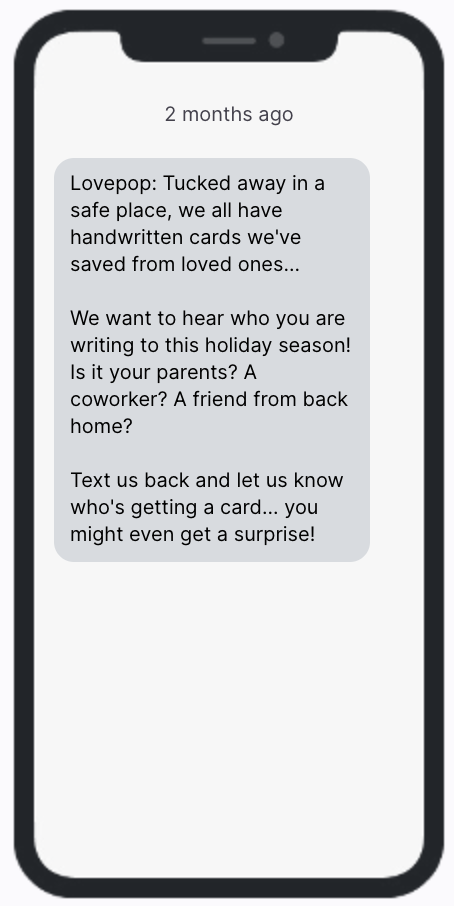
The team received about 2,000 responses—but the volume wasn’t the only thing that overwhelmed the Lovepop team.
Customers shared deeply personal accounts of sending cards to elderly family members confined in long-term care facilities with COVID-induced “no visitor” policies. They wrote about celebrating retirements and cancer remission. They talked about lost loved ones and new beginnings.
“We were crying as we were reading through these stories,” Chapman said, noting that the team felt compelled to write unique replies for the vast majority of incoming messages. “Each story kind of needed its own response,” she said. “I think it took us four days, and responses just kept coming in [the whole time].”
After that experience, Chapman is careful to plan conversational sends around other company initiatives requiring customer support resources. But it certainly hasn’t deterred Lovepop from embracing conversational messaging—if anything, it has reinforced the value of using SMS as a two-way channel that allows customers to be vulnerable. They’re more likely to share a personal story over text than they are publicly on social media.
“Personally I found responding to people really rewarding,” Chapman said. “Most didn’t respond back a second time, but it was really special to acknowledge the stories that they shared. I think responding to customers is an essential part of their relationship with your brand.”
Weiss says OLIPOP ascribes to a similar philosophy. “Folks love that we reply as people versus the brand,” he said. “The beauty of SMS is when it becomes a two-way communication tool. If you are just focusing on slinging messages and not communicating with those that reply, you’re leaving so much magic on the shelf.”
3. Test conversational campaigns with smaller segments first.
If you’re just dipping your toe into the conversational SMS waters, we’d recommend starting small—with a segment of your most engaged subscribers, for example. Think of it as a conversational messaging “soft launch.” You can get a feel for the type and volume of responses you can expect to receive with this sort of send, which will give you a better idea of how to plan for higher-volume conversational campaigns.
Wondering how to create an engaged subscriber segment in Postscript? This intro to using and/or connectors is a great place to start.
4. Designate a person or team to monitor incoming texts on a regular basis—preferably daily, at minimum.
Larger companies with dedicated support or customer experience teams may have the capacity to ensure incoming messages receive responses within minutes. Smaller companies—especially those where one individual is responsible for all SMS to-dos—may only be able to check in once or twice a day.
Either way, make sure you stay consistent. Subscribers will be much happier to receive a response a few hours after they texted you than they will be if you ignore them altogether. While you should strive for the quickest response time possible (think about your response expectations in your personal life), don’t let a little lag deter you from embracing conversational messaging.
And if the personal responses start to get away from you, set up an automatic reply letting subscribers know that someone will be in touch with them shortly!
5. The more people involved in replying to incoming messages, the more you should consider using an integrated ticketing system.
Some Postscript customers manage incoming messages directly from the Responses tab inside of the app—and for many brands, that works perfectly fine.
But if you have several different people or teams owning responses—especially if some of those people work in a customer support capacity—then you may want to think about using one of our many help desk integrations to more seamlessly work text responses into your existing support ticket workflow.
Lovepop, for example, uses Postscript’s integration with Zendesk to empower their Customer Happiness Team to handle incoming texts the same way they handle other incoming requests.
“On a daily basis, there’s maybe a dozen responses that come in,” Chapman said. “They’re usually about the incentive they received when they signed up [for SMS]. Or, they want help with their subscription—sometimes they want to unsubscribe. Sometimes they need help with an order. The Happiness team handles those in Zendesk.”
Obviously, response volume increases when Chapman fires off a conversational campaign—so she usually jumps into the Postscript Responses tab to help with those. She also occasionally pops into Zendesk to see how many SMS responses are coming in—and what they’re about. “That can be really helpful,” she said. “It lets me know if there are more problems than usual, which might mean I need to call up our Happiness team and ask for extra support.”
Olipop uses a similar integration with their help desk of choice, Gorgias. “We use Gorgias to handle all responses, as we prefer each one to show up as a ticket and be handled in the same platform that we handle all other inquiries,” Weiss said. “Each response creates a ticket, and the [Customer Experience] team replies to every single one!”
Weiss added that the team fields about 50 incoming SMS messages per day, aiming to reply within 30 minutes.
Learn more about all the help desk integrations available to Postscript customers here.
Postscript also integrates with Slack, allowing merchants to receive and reply to text messages in a dedicated Slack channel. Simply reply in a thread, and the subscriber will receive your response via text like they would any other message. Setting up the integration is easy—just follow the steps outlined in this help center article.
6. Use topic and sentiment analysis to triage incoming messages.
If you do use Postscript’s Responses tab, our Topic and Sentiment labels can help you sort and prioritize incoming messages.
Our system analyzes each message and automatically selects the topic that best matches its content. There are 10 possible options, including “Shipping,” “Returns,” “Product,” and “Payment.”
Postscript will also apply the appropriate sentiment label (Positive, Negative, or Neutral), with messages determined to be strongly positive or strongly negative marked with the 😁 or 😖 emoji, respectively.
This allows you to quickly identify subscribers who are angry or upset—and ensure they get the assistance they need ASAP.
Learn more about using Response labels in Postscript here.
7. Take advantage of the opportunity to generate reviews and fan content from your happiest subscribers.
While you definitely want to focus on solving subscriber issues first, don’t forget about those smiley faces! Positive incoming messages give you an excellent—and totally organic—opportunity to ask for reviews or user-generated content.
So, when responding to praise-filled messages, resist the urge to reply “Thanks!”—and nothing else. If the customer took the time to text you something positive about your brand or your products, there’s a really good chance they’ll take the time to snap a picture or leave a quick public-facing review. All you have to do is ask!
In addition to case-by-case requests, consider sending UGC or review-focused campaigns to a segment of engaged subscribers.
For example, as the ski season was winding down, J Skis sent this message asking subscribers to share photos from their favorite memories on the mountain that winter:
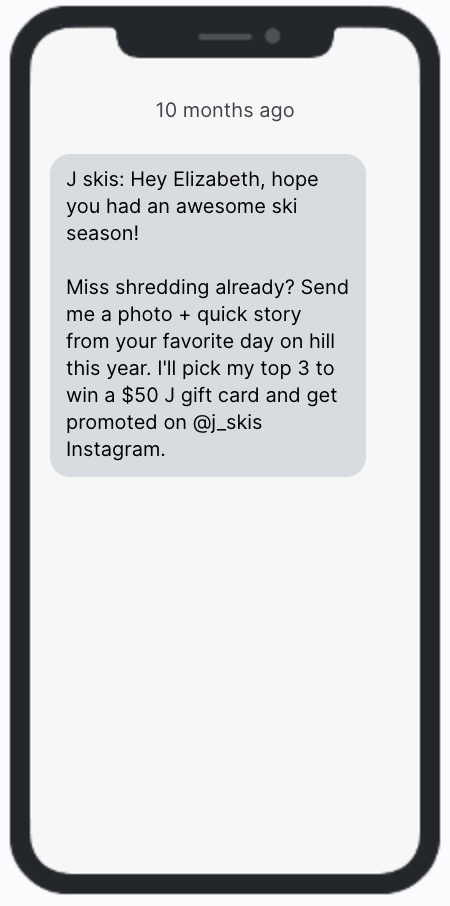
The timing of this message was brilliant. J Skis knew many subscribers wouldn’t be in a ski-purchasing mindset at the end of April—but they could still drive value through SMS by collecting content they could use to promote their brand all year long.
Conversational messaging is the superpower of SMS marketing. But to get the most out of it—and ensure subscribers experience it the way they should—you’ve gotta treat their responses the same way you would a message from a friend or family member. In other words, don’t become the next “no text back” meme.
Looking for conversational campaign ideas and examples? We gotchu! Head over to Fantastic Texts for real text inspo from real merchants.



